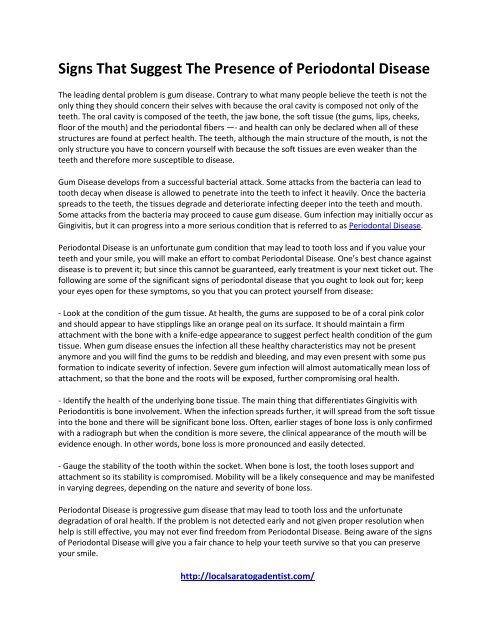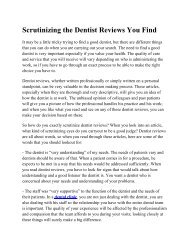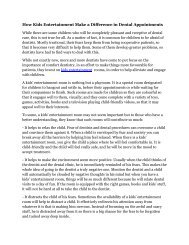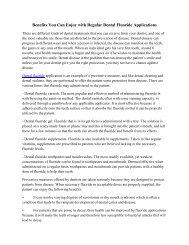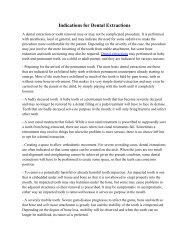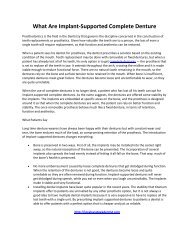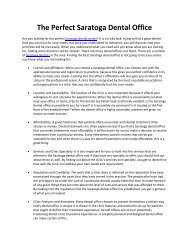Signs That Suggest The Presence of Periodontal Disease
Periodontal Disease is progressive gum disease that may lead to tooth loss and the unfortunate degradation of oral health. Being aware of the signs of Periodontal Disease will give you a fair chance to help your teeth survive. http://localsaratogadentist.com/
Periodontal Disease is progressive gum disease that may lead to tooth loss and the unfortunate degradation of oral health. Being aware of the signs of Periodontal Disease will give you a fair chance to help your teeth survive. http://localsaratogadentist.com/
Create successful ePaper yourself
Turn your PDF publications into a flip-book with our unique Google optimized e-Paper software.
<strong>Signs</strong> <strong>That</strong> <strong>Suggest</strong> <strong>The</strong> <strong>Presence</strong> <strong>of</strong> <strong>Periodontal</strong> <strong>Disease</strong><br />
<strong>The</strong> leading dental problem is gum disease. Contrary to what many people believe the teeth is not the<br />
only thing they should concern their selves with because the oral cavity is composed not only <strong>of</strong> the<br />
teeth. <strong>The</strong> oral cavity is composed <strong>of</strong> the teeth, the jaw bone, the s<strong>of</strong>t tissue (the gums, lips, cheeks,<br />
floor <strong>of</strong> the mouth) and the periodontal fibers —- and health can only be declared when all <strong>of</strong> these<br />
structures are found at perfect health. <strong>The</strong> teeth, although the main structure <strong>of</strong> the mouth, is not the<br />
only structure you have to concern yourself with because the s<strong>of</strong>t tissues are even weaker than the<br />
teeth and therefore more susceptible to disease.<br />
Gum <strong>Disease</strong> develops from a successful bacterial attack. Some attacks from the bacteria can lead to<br />
tooth decay when disease is allowed to penetrate into the teeth to infect it heavily. Once the bacteria<br />
spreads to the teeth, the tissues degrade and deteriorate infecting deeper into the teeth and mouth.<br />
Some attacks from the bacteria may proceed to cause gum disease. Gum infection may initially occur as<br />
Gingivitis, but it can progress into a more serious condition that is referred to as <strong>Periodontal</strong> <strong>Disease</strong>.<br />
<strong>Periodontal</strong> <strong>Disease</strong> is an unfortunate gum condition that may lead to tooth loss and if you value your<br />
teeth and your smile, you will make an effort to combat <strong>Periodontal</strong> <strong>Disease</strong>. One’s best chance against<br />
disease is to prevent it; but since this cannot be guaranteed, early treatment is your next ticket out. <strong>The</strong><br />
following are some <strong>of</strong> the significant signs <strong>of</strong> periodontal disease that you ought to look out for; keep<br />
your eyes open for these symptoms, so you that you can protect yourself from disease:<br />
- Look at the condition <strong>of</strong> the gum tissue. At health, the gums are supposed to be <strong>of</strong> a coral pink color<br />
and should appear to have stipplings like an orange peal on its surface. It should maintain a firm<br />
attachment with the bone with a knife-edge appearance to suggest perfect health condition <strong>of</strong> the gum<br />
tissue. When gum disease ensues the infection all these healthy characteristics may not be present<br />
anymore and you will find the gums to be reddish and bleeding, and may even present with some pus<br />
formation to indicate severity <strong>of</strong> infection. Severe gum infection will almost automatically mean loss <strong>of</strong><br />
attachment, so that the bone and the roots will be exposed, further compromising oral health.<br />
- Identify the health <strong>of</strong> the underlying bone tissue. <strong>The</strong> main thing that differentiates Gingivitis with<br />
Periodontitis is bone involvement. When the infection spreads further, it will spread from the s<strong>of</strong>t tissue<br />
into the bone and there will be significant bone loss. Often, earlier stages <strong>of</strong> bone loss is only confirmed<br />
with a radiograph but when the condition is more severe, the clinical appearance <strong>of</strong> the mouth will be<br />
evidence enough. In other words, bone loss is more pronounced and easily detected.<br />
- Gauge the stability <strong>of</strong> the tooth within the socket. When bone is lost, the tooth loses support and<br />
attachment so its stability is compromised. Mobility will be a likely consequence and may be manifested<br />
in varying degrees, depending on the nature and severity <strong>of</strong> bone loss.<br />
<strong>Periodontal</strong> <strong>Disease</strong> is progressive gum disease that may lead to tooth loss and the unfortunate<br />
degradation <strong>of</strong> oral health. If the problem is not detected early and not given proper resolution when<br />
help is still effective, you may not ever find freedom from <strong>Periodontal</strong> <strong>Disease</strong>. Being aware <strong>of</strong> the signs<br />
<strong>of</strong> <strong>Periodontal</strong> <strong>Disease</strong> will give you a fair chance to help your teeth survive so that you can preserve<br />
your smile.<br />
http://localsaratogadentist.com/


